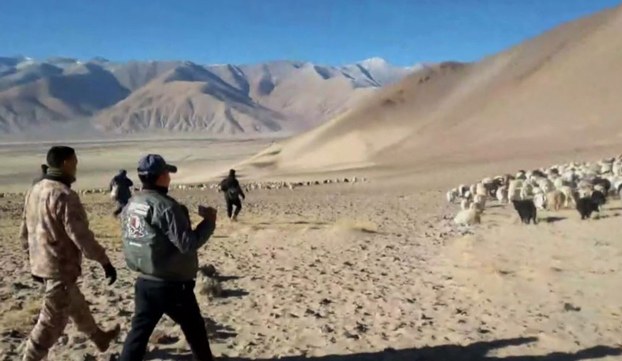In an incident captured on video, Chinese soldiers confronted Tibetan herders in a remote, rugged border region near the border of India and Chinese-controlled Tibet, claiming they were in Chinese territory and denying them access to traditional grazing land.
The Jan. 2 video, taken by a Tibetan nomad named Kunsang Namgyal, shows about a dozen People’s Liberation Army soldiers in desert fatigues talking with herders, gesturing and pointing, while sirens from armored vehicles can be heard in the background.
The herders are heard shouting back shouting in Tibetan: “Why have you come here? Why have you brought your vehicles here? This is our ancestral land. We graze our livestock here.”
One herder used his sling to throw a stone at an armored vehicle, but otherwise there was no violence. No Indian security forces were in sight at the time.
The video was shared with Radio Free Asia and shared on Instagram.
The incident occurred in a rugged border area used by nomads as their winter grazing grounds called Jangthang, or “Northern Plains” in Tibetan, situated between Ladakh, in northern India, and the Chinese-occupied Tibetan Autonomous Region.
The area has seen occasional skirmishes between Indian and Chinese troops. In June 2020, Indian soldiers clashed with Chinese soldiers in an incident that left 20 Indian troops dead.

Buffer zones
To avoid such eruptions, many areas in eastern Ladakh, such as the Kakjung Jangthang area, have been designated as “buffer zones” along the border, with forces from both sides typically refraining from patrolling.
But the buffer zones have taken away the livelihoods of local residents, said Sriparna Pathak, a professor of China studies at the O.P. Jindal Global University in Haryana, India, and a former consultant at India’s foreign ministry.
“Owing to never-ending Chinese incursions, the grazing land has been decreasing,” she said. “If nomadic activities were to decrease further, then further security concerns for India would rise, and there is an urgent need for India to step up defenses and infrastructure in the region.”
The region has three traditional grazing areas, Belung, Daklung and Melung, said Namgyal, who took the video. China has already blocked access to Melung, and now it claims Belung and Daklung, too, he said.
“In the latest incident, the Chinese forces chased away the shepherds from the Belung and Daklung grazing areas and ensured no animals were allowed to graze there,” he said in an interview with RFA Tibetan.

Following the Jan. 2 incident, officials from the Indian army, the Indo-Tibetan Border Police, the local sarpanch – the elected head of a village-level constitutional body – and sub-divisional magistrate, visited the site, said Ishey Spalzang, councilor of the Nyoma constituency that governs Kakjung.
“The growing tensions on the Indo-Tibet border between India and China has resulted in the loss of grazing land for the nomads along the border,” Spalzang said.
Border dispute unresolved
Confrontations between nomads and Chinese troops have occurred in the past, particularly in grazing areas where herders in the Kakjung Jangthang and nearby villages such as Nyoma and Chushul usually tend livestock, locals said.
“Disturbances of this kind caused by the PLA soldiers to nomads take place frequently,” Spalzang said, referring to Chinese troops. “However, no harm has been reported from such incidents.”
Indian forces typically allow the nomads to graze their animals in the areas where they have traditionally done so, but the Chinese always deny the shepherds access to different areas at different times, he said.
“The Indian government must take an earnest look at helping the nomads in their times of need by allowing them to herd their animals like they have done in the past,” Spalzang added.

Randhir Jaiswal, a spokesman for India’s Ministry of External Affairs, said during a press conference, said that “the two sides are aware of the traditional grazing areas in the border regions,” and that “any incident of friction is dealt with through established mechanisms as appropriate.”
Several rounds of talks to resolve the border issue between India and China have since ensued, but new details revealed during a recent Indian army gallantry award citation showed that Indian and Chinese troops clashed at least two times in 2022, the most recent of which took place in November 2022.
In that incident, Indian soldiers reportedly pushed back a group of 40-50 Chinese soldiers who were trying to enter Indian territory in Ladakh.
Translated by Tenzin Pema for RFA Tibetan. Edited by Roseanne Gerin and Malcolm Foster.





